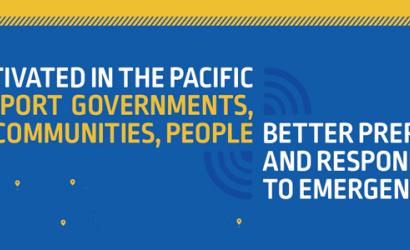Kiribati
Lying at only three to four meters above sea level, the Republic of Kiribati is one of the world’s most exposed countries to extreme climate change and sea level rise, posing existential threats to food security, freshwater resources, and national infrastructure. The low-lying atoll nation faces increasing challenges from coastal erosion to saltwater intrusion, which severely impact agricultural production and exacerbate food insecurity. More frequent and intense extreme weather events, including droughts and king tides, disrupt essential supply chains and food security across Kiribati’s 33 dispersed coral atolls.
In response, the Kiribati Joint Implementation Plan for Climate Change and Disaster Risk Management (KJIP) and the Climate Change Policy outline a strategic path towards adaptation and resilience, emphasizing coastal protection, sustainable water management, and climate-resilient agriculture. These policies reflect Kiribati's proactive stance in the face of overwhelming odds, highlighting the urgent need for global cooperation, partnership and support to safeguard its future.
Telecommunications infrastructure in Kiribati is expanding rapidly in 2025, driven by strategic investments in submarine cable systems and domestic fibre networks. The East Micronesia Cable System (EMCS), funded by Australia, Japan, and the USA, will connect South Tarawa to Nauru, Kosrae (FSM), and onward to Guam, providing resilient international connectivity. In parallel, the Kiritimati Cable Project will link Kiritimati Island to the Southern Cross NEXT cable via a submarine spur (a 375 km undersea cable), replacing its reliance on satellite internet. Domestically, the Government is building a fibre-optic backbone network in South Tarawa to connect public institutions and support private sector services managed by the state-owned BwebwerikiNet Limited. These developments are part of a broader national strategy to bridge the digital divide and improve service delivery across Kiribati’s widely dispersed islands.
Vodafone is Kiribati's sole operator for mobile, fixed-line, and broadband services. Meanwhile, Lynk provides direct-to-mobile satellite services, complementing terrestrial mobile networks.
Responsibility for coordinating National Emergency Telecommunications efforts falls under the Ministry of Information, Communications, and Transport (MICT), under the coordination of the National Disaster Management Office.
ICT Profile
National Disaster Management Office (NDMO)
Ministry of Information, Communications and Transport (MICT)
Communications Commission of Kiribati (CCK)
134,518
Lying at only three to four meters above sea level, the Republic of Kiribati is one of the world’s most exposed countries to extreme climate change and sea-level rise, posing existential threats to food security, freshwater resources, and national infrastructure. The low-lying atoll nation faces increasing challenges from coastal erosion to saltwater intrusion, which severely impact agricultural production and exacerbate food insecurity. More frequent and intense extreme weather events, including droughts and king tides, disrupt essential supply chains and food security across Kiribati’s 33 dispersed coral atolls.
In response, the Kiribati Joint Implementation Plan for Climate Change and Disaster Risk Management (KJIP) and Climate Change Policy outline a strategic path towards adaptation and resilience, emphasizing coastal protection, sustainable water management, and climate-resilient agriculture. These policies reflect Kiribati's proactive stance in the face of overwhelming odds, highlighting the urgent need for global cooperation, partnership and support to safeguard its future.
Telecommunications infrastructure in Kiribati is expanding rapidly in 2025, driven by strategic investments in submarine cable systems and domestic fibre networks. The East Micronesia Cable System (EMCS), funded by Australia, Japan, and the USA, will connect South Tarawa to Nauru, Kosrae, and onward to Guam, providing resilient international connectivity. In parallel, the Kiritimati Cable Project will link Kiritimati Island to the Southern Cross NEXT cable via a submarine spur, replacing its reliance on satellite internet. Domestically, the government is building a fibre-optic backbone network in South Tarawa to connect public institutions and support private sector services, with BwebwerikiNet Limited (BNL) managing the infrastructure. These developments are part of a broader national strategy to bridge the digital divide and improve service delivery across Kiribati’s widely dispersed islands.
Responsibility for coordinating National Emergency Telecommunications efforts falls under the Ministry of Information, Communications, and Transport (MICT), under the coordination of the National Disaster Management Office.
Kiribati Dollar
0
51
0.04
48
41.3%
73%
National Disaster Management Act of 1993
-Kiribati’s Disaster Management Policy is structured around the National Disaster Risk Management Plan (NDRMP), which was formalized in 2012 and is guided by the National Disaster Management Act of 1993. This framework integrates disaster risk reduction, climate change adaptation, and sustainable development.The National Disaster Risk Management Office (NDRMO) under the Office of the President is responsible for coordinating and monitoring the implementation of the NDRMP.
National ICT Policy 2019
Communications Act 2013
-Kiribati’s Telecommunications Policy is guided by the National ICT Policy 2019, the Communications Act 2013, and the Ministry of Information, Communications and Transport (MICT) Strategic Plan 2025–2028. These frameworks collectively aim to improve digital access, regulatory oversight, and infrastructure development across the country.
-Kiribati currently has no formal national UAV (drone) regulations, but drone operations are guided by international standards, particularly those from the International Civil Aviation Organization (ICAO) and the Pacific Aviation Safety Office (PASO).
General Guidelines for Drone Use
Keep drones within visual line of sight.
Do not fly over people, property, or vehicles within 50 meters.
Do not exceed 150 meters (490 feet) altitude.
Stay at least 8 km (5 miles) away from airports.
Avoid flying in sensitive areas (e.g., government or military zones).
Read and follow the drone’s user manual and perform pre-flight checks.

